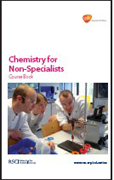
Chemistry for non-specialists: course book
Designed with the non-specialist teacher in mind, the emphasis of this book is to provide them with the confidence, flair and enthusiasm to teach chemistryat KS3 or KS4. Provision of 80 experiments to inspire and engage the students, practical help with the experiments and health and safety guidance means theteacher has all the tools they might require when improving the teaching of chemistry. Originally developed as course material for the Royal Society of Chemistry (RSC) Chemistry for Non-Specialist course, organised in collaboration with the national network of Science Learning Centres (SLCs) and supported by an unrestricted educational grant from GlaxoSmithKline (GSK), the resources aretried and tested and known to be effective. The course book is accompanied bya CD-ROM and together they make a valuable addition to the educational resources and aids for non-specialist teachers teaching chemistry. ÍNDICE: Health and safety guidance; The CLEAPSS(R) science resources web site and CD-ROM 6;CLEAPSS(R) helpline;Experiments: 1 Diffusion of gases - ammonia and hydrogen chloride; 2 Handling liquid bromine and preparing bromine water; 3 Diffusion of gases - a safer alternative to bromine; 4 Diffusion in liquids; 5 Allotropes of sulphur; 6 Making glass; 7 Chocolate and structure; 8 Experiments with hydrogels - hair gel and disposable nappies; 9 Experiments with hydrogels - plant water storage crystals; 10 Cross-linking polymers - alginate worms; 11 Extracting limonene from oranges by steam distillation; 12 Generating, collecting, and testing gases; 13 An alternative to using compressed gas cylinders; 14 Making a reaction tube;15 Ammonia fountain; 16 Titrating sodium hydroxide with hydrochloric acid;17 Using indigestion tablets to neutralise an acid; 18 A thermometric titration; 19 Universal indicator 'rainbow'; 20 An effervescent universal indicator 'rainbow'; 21 Neutralisation circles; 22 Indicators and dry ice: demonstration; 23 Thermal decomposition of calcium carbonate; 24 Reacting elements with oxygen; 25 Reacting elements with chlorine; 26 Identifying the products of combustion; 27 The 'Whoosh' bottle demonstration; 28 Fat-pan fire!; 29 Money to burn; 30 The methane rocket; 31 The thermal decomposition of nitrates - 'writing with fire'; 32 Iron and sulfur reaction; 33 The reaction between zinc powder and sulphur; 34 Reaction between aluminium and iodine; 35 Reaction of zinc with iodine; 36 The combustion of iron wool; 37 The change in mass when magnesium burns; 38 Competition for oxygen; 39 Displacement reactions between metals and their salts; 40 Extracting metals with charcoal; 41 Extraction of iron on a match head!; 42 The reaction between zinc and copper oxide; 43 The thermite reaction; 44 Making silicon and silanes from sand; 45Reduction of copper(II) oxide with methane; 46 Finding the formula of copper oxide; 47 The reaction of magnesium with steam; 48 The 'blue bottle' experiment; 49 Turning copper coins into 'silver' and 'gold'; 50 Alkali metals; 51 Heating Group 1 metals in air and in chlorine; 52 Reactions of aqueous solutions of the halogens; 53 Halogen reactions with iron; 54 Colourful electrolysis; 55 Electrolysis of zinc chloride; 56 Identifying the products of electrolysis; 57Electrolysis of potassium iodide solution; 58 Endothermic solid-solid reactions; 59 Exothermic or endothermic?; 60 Chemiluminescence - cold light; 61 Spontaneous exothermic reaction; 62 The effect of concentration on reaction rate; 63 Iodine clock reaction; 64 Rates and rhubarb; 65 Catalysts for the decomposition of hydrogen peroxide; 66 Controlled explosion of a hydrogen-air mixture; 67 Controlled explosion of a methane-air mixture; 68 Exploding balloons; 69 Thehowling/screaming jelly baby; 70 Hydrogen/oxygen explosion; 71 Exploding bubbles of hydrogen and oxygen; 72 An oscillating reaction; 73 The fractional distillation of crude oil; 74 Cracking hydrocarbons; 75 Making nylon - the 'nylon rope trick'; 76 PVA polymer slime; 77 Reactions of positive ions with sodium hydroxide (microscale version); 78 Testing for negative ions; 79 Flame tests (wooden splint method) 80 Flame colours - a demonstration; Self test questionnaire; RSC resources; Index
- ISBN: 978-1-84973-112-6
- Editorial: Royal Society of Chemistry
- Encuadernacion: Desconocida
- Páginas: 262
- Fecha Publicación: 01/04/2010
- Nº Volúmenes: 1
- Idioma: Inglés
